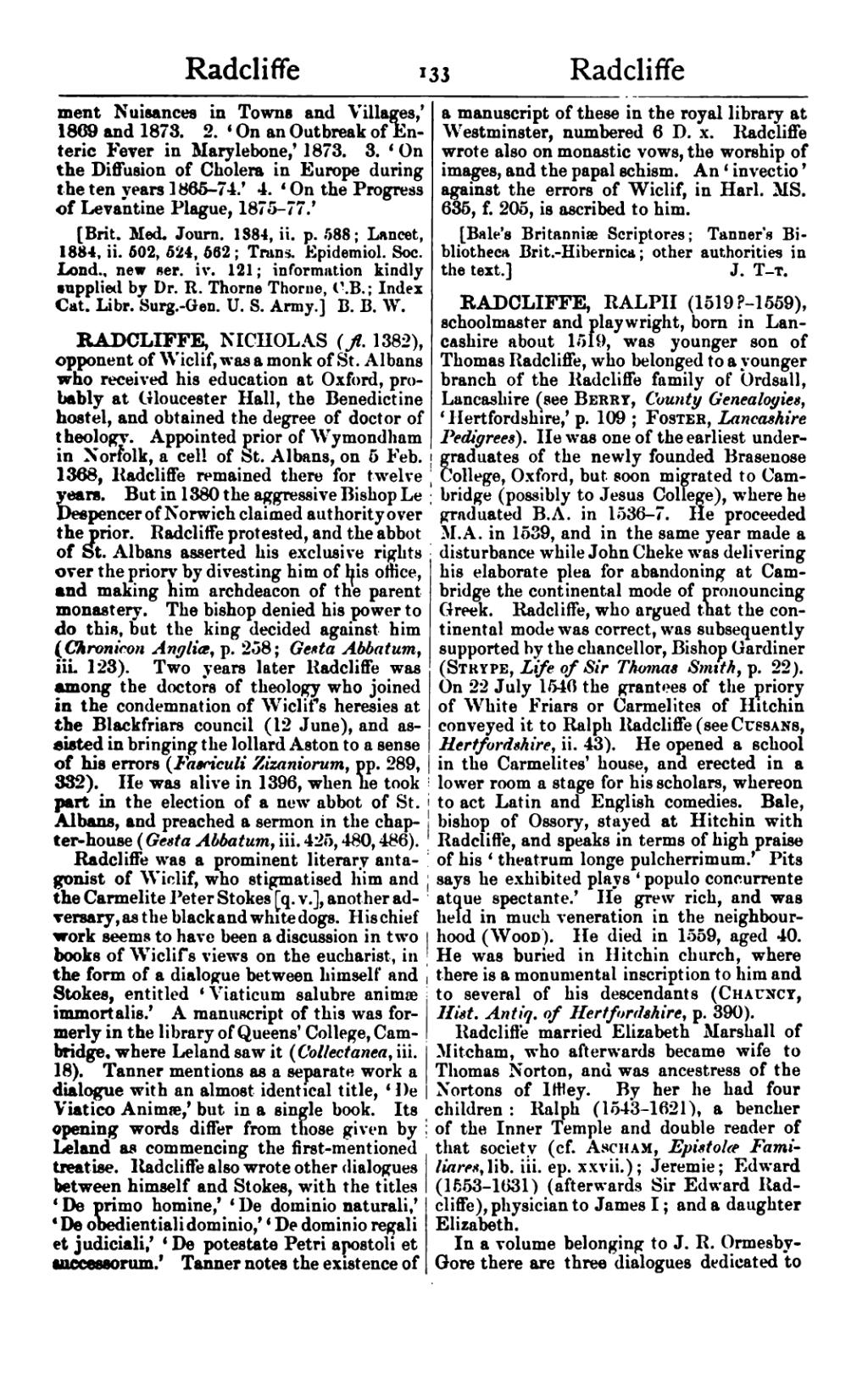ment Nuisances in Towns and Villages,’ 1869 and 1873. 2. ‘On an Outbreak of Enteric Fever in Marylebone,’ 1873. 3. ‘On the Diffusion of Cholera in Europe during the ten years 1865–74.’ 4. ‘On the Progress of Levantine Plague, 1875–77.’
[Brit. Med. Journ. 1884, ii. p. 588; Lancet, 1884, ii. 502, 524, 562; Trans. Epidemiol. Soc. Lond., new ser. iv. 121; information kindly supplied by Dr. R. Thorne Thorne, C.B.; Index Cat. Libr. Surg.-Gen. U.S. Army.]
RADCLIFFE, NICHOLAS (fl. 1382), opponent of Wiclif, was a monk of St. Albans who received his education at Oxford, probably at Gloucester Hall, the Benedictine hostel, and obtained the degree of doctor of theology. Appointed prior of Wymondham in Norfolk, a cell of St. Albans, on 5 Feb. 1368, Radcliffe remained there for twelve years. But in 1380 the aggressive Bishop Le Despencer of Norwich claimed authority over the prior. Radcliffe protested, and the abbot of St. Albans asserted his exclusive rights over the priory by divesting him of his office, and making him archdeacon of the parent monastery. The bishop denied his power to do this, but the king decided against him (Chronicon Angliæ, p. 258; Gesta Abbatum, iii. 123). Two years later Radcliffe was among the doctors of theology who joined in the condemnation of Wiclif's heresies at the Blackfriars council (12 June), and assisted in bringing the lollard Aston to a sense of his errors (Fasciculi Zizaniorum, pp. 289, 332). He was alive in 1396, when he took part in the election of a new abbot of St. Albans, and preached a sermon in the chapter-house (Gesta Abbatum, iii. 425, 480, 486).
Radcliffe was a prominent literary antagonist of Wiclif, who stigmatised him and the Carmelite Peter Stokes [q. v.], another adversary, as the black and white dogs. His chief work seems to have been a discussion in two books of Wiclif's views on the eucharist, in the form of a dialogue between himself and Stokes, entitled ‘Viaticum salubre animæ immortalis.’ A manuscript of this was formerly in the library of Queens' College, Cambridge, where Leland saw it (Collectanea, iii. 18). Tanner mentions as a separate work a dialogue with an almost identical title, ‘De Viatico Animæ,’ but in a single book. Its opening words differ from those given by Leland as commencing the first-mentioned treatise. Radcliffe also wrote other dialogues between himself and Stokes, with the titles ‘De primo homine,’ ‘De dominio naturali,’ ‘De obedientiali dominio,’ ‘De dominio regali et judiciali,’ ‘De potestate Petri apostoli et successorum.’ Tanner notes the existence of a manuscript of these in the royal library at Westminster, numbered 6 D. x. Radcliffe wrote also on monastic vows, the worship of images, and the papal schism. An ‘invectio’ against the errors of Wiclif, in Harl. MS. 635, f. 205, is ascribed to him.
[Bale's Britanniæ Scriptores; Tanner's Bibliotheca Brit.-Hibernica; other authorities in the text.]
RADCLIFFE, RALPH (1519?–1559), schoolmaster and playwright, born in Lancashire about 1519, was younger son of Thomas Radcliffe, who belonged to a younger branch of the Radcliffe family of Ordsall, Lancashire (see Berry, County Genealogies, ‘Hertfordshire,’ p. 109; Foster, Lancashire Pedigrees). He was one of the earliest undergraduates of the newly founded Brasenose College, Oxford, but soon migrated to Cambridge (possibly to Jesus College), where he graduated B.A. in 1536–7. He proceeded M.A. in 1539, and in the same year made a disturbance while John Cheke was delivering his elaborate plea for abandoning at Cambridge the continental mode of pronouncing Greek. Radcliffe, who argued that the continental mode was correct, was subsequently supported by the chancellor, Bishop Gardiner (Strype, Life of Sir Thomas Smith, p. 22). On 22 July 1546 the grantees of the priory of White Friars or Carmelites of Hitchin conveyed it to Ralph Radcliffe (see Cussans, Hertfordshire, ii. 43). He opened a school in the Carmelites' house, and erected in a lower room a stage for his scholars, whereon to act Latin and English comedies. Bale, bishop of Ossory, stayed at Hitchin with Radcliffe, and speaks in terms of high praise of his ‘theatrum longe pulcherrimum.’ Pits says he exhibited plays ‘populo concurrente atque spectante.’ He grew rich, and was held in much veneration in the neighbourhood (Wood). He died in 1559, aged 40. He was buried in Hitchin church, where there is a monumental inscription to him and to several of his descendants (Chauncy, Hist. Antiq. of Hertfordshire, p. 390).
Radcliffe married Elizabeth Marshall of Mitcham, who afterwards became wife to Thomas Norton, and was ancestress of the Nortons of Iffley. By her he had four children: Ralph (1543–1621), a bencher of the Inner Temple and double reader of that society (cf. Ascham, Epistolæ Familiares, lib. iii. ep. xxvii.); Jeremie; Edward (1553–1631) (afterwards Sir Edward Radcliffe), physician to James I; and a daughter Elizabeth.
In a volume belonging to J. R. Ormesby-Gore there are three dialogues dedicated to
